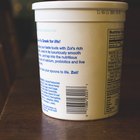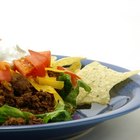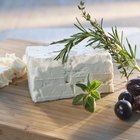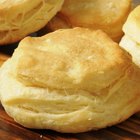
Add some extra moisture and flavor to your baked goods using yogurt. Both Greek and plain yogurt are made from milk to which live cultures have been added. Greek yogurt is thicker than plain yogurt and usually has more protein. Both types of yogurt can replace other dairy products in baking, but consider the dairy product you're replacing when choosing one type of yogurt over the other.
Clean Up the Crumbs
The main differences between regular yogurt and Greek yogurt is the thickness and the protein content. Regular yogurts are typically much thinner than Greek yogurt and they contain less protein. In baked goods, the thinner, watery consistency can result in a tougher end product. Greek yogurt is similar to sour cream in that it makes baked goods moist and tender, with a fine crumb. In most cases, Greek yogurt provides a better texture in baked goods. On the other hand, if you're using a recipe designed for regular yogurt, Greek yogurt may be too thick. In this case, thin the Greek yogurt with a little milk.
Taste the Difference
Greek yogurt has a pronounced tang that balances the sweetness of many baked good recipes in the same way sour cream would. Plain yogurt has a milder taste. Although manufacturers are constantly adding more flavors, you'll probably find more flavor choices in regular yogurt. For most baked goods, go with an unflavored or vanilla plain or Greek yogurt. For cheesecakes, you may appreciate the wide flavor selection available for plain yogurt.
Count Your Pennies
Greek yogurt is generally more expensive than regular plain yogurt. If you're counting pennies, opt for regular yogurt, or make your own Greek yogurt. Place a coffee filter in a sieve and place the sieve over a bowl. Fill the sieve with regular yogurt and refrigerate overnight. The water in the yogurt will drain, leaving behind a thick Greek-style yogurt. Keep the liquid, which is whey, and can be used as a substitute for buttermilk in baking.
Make Up Your Mind
Here's a quick tip for using yogurt in baking: use Greek yogurt in place of sour cream, but use plain yogurt when a recipe calls for buttermilk. If a recipe calls for yogurt, use plain yogurt unless the recipe specifically calls for Greek yogurt. Whole or low-fat yogurt generally produces better results than nonfat yogurt in baked goods, because the fat acts as a tenderizer. You can use nonfat yogurt, but the result might be harder.
Related Articles

How to Freeze Greek Yogurt

What Can I Use in Place of Sour Cream?

Feta Cheese Nutrition

Greek Yogurt as a Replacement for Sour ...

How to Substitute With Dry Milk

How Many Calories Are in a Goat Cheese ...

What Is Balkan Yogurt?

Why Does Greek Yogurt Have More Protein ...

How to Get Leg Wax Off Skin

What Can Be Used to Substitute for ...
Nutrition Information for Onken Yogurt

How to Make Southern Buttermilk ...

How to Cook a Crispy Duck in a ...

How to Use Buttermilk That Has Passed ...

Kefir Substitute

How to Tell the Size of Havaianas

Can I Substitute Bleached for ...

Butter Substitute for Baking Scones

How to Replace Eggs With Mayonnaise
How to Substitute Yogurt for Oil
References
Writer Bio
Julie Christensen is a food writer, caterer, and mom-chef. She's the creator of MarmaladeMom.org, dedicated to family fun and delicious food, and released a book titled "More Than Pot Roast: Fast, Fresh Slow Cooker Recipes."
Photo Credits
George Doyle/Stockbyte/Getty Images